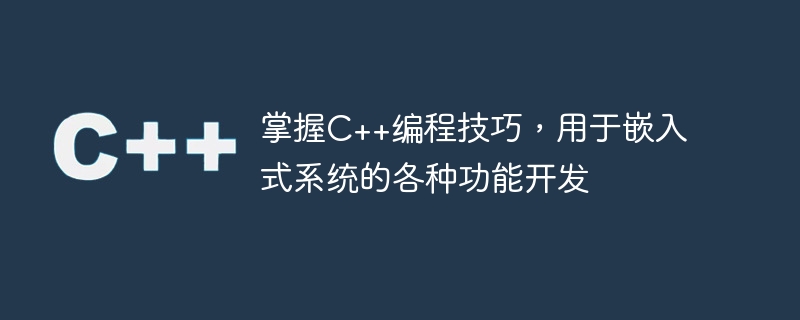

Master C programming skills for the development of various functions of embedded systems
In the field of embedded systems, C is a widely used programming language. Its powerful object-oriented features and efficient performance make C one of the preferred languages for developing various functions of embedded systems. This article will introduce some C programming techniques commonly used in embedded system development, and illustrate them with code examples.
1. Use classes and objects for modular design
Object-oriented programming is one of the biggest features of C. In embedded system development, modular design using classes and objects can make the code structure clearer and easier to maintain and reuse. For example, to develop a module that controls LED lights, you can define a class named LED, which contains methods and member variables for operating LED lights. The following is a simple sample code:
class LED {
public:
void turnOn();
void turnOff();
private:
int pin;
};
void LED::turnOn() {
// 控制LED灯点亮的代码
}
void LED::turnOff() {
// 控制LED灯关闭的代码
}Using the LED class can easily operate multiple LED lights, improving the readability and maintainability of the code.
2. Use virtual functions to achieve polymorphism
Polymorphism is one of the very important concepts in object-oriented programming. By using virtual functions, unified calls between different derived classes can be achieved. In embedded system development, virtual functions can be used to achieve a unified interface for different hardware devices. The following is a simple sample code:
class Device {
public:
virtual void init() = 0;
virtual void sendData(const char* data) = 0;
};
class UART : public Device {
public:
void init() override {
// UART设备初始化的代码
}
void sendData(const char* data) override {
// 发送数据的代码
}
};
class SPI : public Device {
public:
void init() override {
// SPI设备初始化的代码
}
void sendData(const char* data) override {
// 发送数据的代码
}
};
void initialize(Device* device) {
device->init();
}
void sendData(Device* device, const char* data) {
device->sendData(data);
}By defining an abstract Device class and implementing virtual functions in derived classes, the operations of initialization and data sending can be uniformly called on different devices.
3. Use smart pointers to manage dynamic memory
In embedded system development, dynamic memory management is a very important issue. To avoid problems like memory leaks and dangling pointers, you can use smart pointers for memory management. The following is a sample code:
class Example {
public:
Example() {
// 创建资源的代码
}
~Example() {
// 释放资源的代码
}
};
void exampleFunc() {
std::shared_ptr<Example> example = std::make_shared<Example>();
// 使用example指向的资源
// ...
// 不需要再手动释放资源,智能指针会自动管理内存
}By using std::shared_ptr, memory can be automatically released during dynamic memory allocation, avoiding the problem of memory leaks.
This article introduces some C programming techniques commonly used in embedded system development, and illustrates them with code examples. Mastering these skills can make embedded system development more efficient and easier to maintain. Of course, this is just the tip of the iceberg of C programming skills. I hope readers can further learn and apply them to improve their abilities in the field of embedded system development.
The above is the detailed content of Master C++ programming skills for the development of various functions of embedded systems. For more information, please follow other related articles on the PHP Chinese website!




